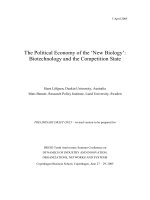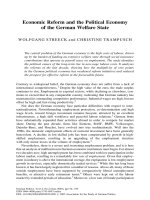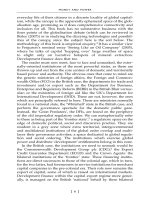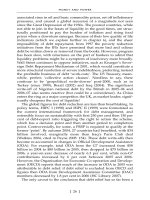The Political Economy of Distress in East Asian Financial Institutions
Bạn đang xem bản rút gọn của tài liệu. Xem và tải ngay bản đầy đủ của tài liệu tại đây (66.59 KB, 22 trang )
1
The Political Economy of Distress in
East Asian Financial Institutions
by
Paola Bongini
†
, Stijn Claessens
‡
and Giovanni Ferri
‡
Abstract
It has long been acknowledged that politics and regulatory capture can play an important
role in dealing with financial institutions’ distress. The East Asia financial crisis meant a
large number of distressed and closed intermediaries in an environment with many links
between government, supervisors, politicians and financial institutions. This makes for a
good event for studying how such connections affect the resolution of financial
institutions’ distress. We investigate the occurrence of distress and closure decisions for
186 banks and 97 nonbank financial institutions from Indonesia, Korea, Malaysia, the
Philippines and Thailand. We find that 42 percent of the institutions experienced distress
after July 1997. By July 1999, 13 percent of all institutions in existence in July 1997 had
been closed. Using 1996 financial data, we find that traditional, CAMEL-type
variablesloan loss reserves to capital, loan growth, net interest income to total income,
return on assets, and loans to borrowingshelp predict subsequent distress and closure.
None of the foreign controlled institutions was closed and the degree of foreign portfolio
ownership lowered an institution’s probability of distress. “Connections”with
industrial groups or influential familiesincreased the probability of distress, suggesting
that supervisors had granted selective prior forbearance from prudential regulations.
Connections made closure more, not less likely, however, suggesting that the closure
processes themselves were transparent. Larger institutions were more likely distressed,
but less likely closed, while (smaller) nonbank financial institutions were more likely
closed, suggesting a “Too Big To Fail” policy. These policies, together with the fact that
resolution processes were late and not necessarily comprehensive, may have added to the
overall uncertainty and loss of confidence in the East Asian countries, aggravating the
financial crisis.
†
Università degli Studi di Macerata. Contact address: Paola Bongini, Via Eva Segrè 3, 20052 Monza, Italy;
tel: (0039) (039) 737-257, fax (0039) (02) 7234-2702; email:
‡
The World Bank.
Contact addresses: Stijn Claessens, The World Bank, 1818 H Street, 20433 Washington D.C. tel: (202)
473-2712, fax (202) 522-2031, email: , and Giovanni Ferri, tel: (202) 473-2004,
fax (202) 455-524 email: We would like to thank participants in the Fourth
Washington Area Finance Conference and especially our discussant, David Nickerson for very useful
comments.
2
JEL classification numbers: G21, G33, G38, Keywords: financial sector fragility, early warning
systems, East-Asia financial crisis
1. Introduction
It has long been acknowledged that extensive relationships between financial
institutions and corporations can add to financial risks. It is also known that politics and
regulatory capture can play an important role in dealing with financial distress. The East
Asia financial crisis meant a large number of distressed and closed intermediaries
clustered within a short span of time in an environment with many links between
government, supervisors, politicians, corporations and financial institutions. This makes
the East Asia financial crisis a good event to investigate the role of these connections in
causing and resolving financial institutions’ distress. Furthermore, the general causes of
the East Asian financial crisis have been the subject of intense debate, with proponents of
a sudden shift of views of (foreign) investors as the main cause on one side and
proponents of weak fundamentals as the major cause on the other side. To date, little
empirical evidence exists as to the role of individual financial institutions’ weaknesses in
contributing to the crisis: were institutions hit by an exogenous shock and became
distressed or were there many weak institutions before the crisis which then led to the
systemic financial distress? And, if the latter, did the resolution processes resolve these
distressed financial institutions in a transparent way or did they add to the overall
uncertainty and loss of confidence?
To explore these questions, we investigate the occurrence of distress and closure
decisions for a sample of 186 banks and 97 nonbank financial institutions from five
crisis-affected East Asian countries: Indonesia, Korea, Malaysia, the Philippines and
Thailand. Coverage of the national financial sector in terms of total assets is high for all
five countries. In terms of banking system assets, the sample covers between 80% and
100%; and in terms of number of banks between 36% and 100%. In terms of assets of
nonbank financial institutions, the coverage of our sample is between 47% and 90%.
Almost 42% of these institutions experienced distress after July 1997, i.e., were either
closed, merged, recapitalized or had their operations temporarily suspended. By July
1999, 13% of all institutions in existence in July 1997 had been closed. This illustrates
the systemic proportions of the East Asian financial crisis.
We document various financial data (balance sheet and income data for end-1996)
for distressed, non-distressed and closed financial institutions and analyze their
ownership structures to explore whether these characteristics help explain distress and
closure. Using the end-1996 financial data, we find that traditional, CAMEL-type
variablesloan loss reserves to capital, loan growth, net interest income to total income,
return on assets, and loans to borrowingspredict subsequent distress and closure well.
Ownership data also help predict financial distress and closure. Foreign portfolio
ownership decreases the probability of financial distress and none of the foreign-
controlled institutions was closed, while privately owned institutions were more likely
distressed. “Connections”with industrial groups or influential familiesincreases the
probability of distress, suggesting that supervisors had granted selective prior forbearance
from prudential regulations. Connections also make closure more, not less likely,
suggesting that the closure processes themselves were transparent. Larger-sized
3
intermediaries were more likely to become distressed, but less likely to be closed,
suggesting a “TBTF” policy. The significant forbearance of already weak financial
institutions granted prior to the crisis together with the late and not necessarily
comprehensive resolution processes, may have added to the overall uncertainty and loss
of confidence in the East Asian countries, aggravating the financial crisis.
The rest of the paper is organized as follows: section 2 provides the motivation
and reviews the literature on financial institutions’ distress and closure. Section 3
describes the data we use, provides a characterization of our sample of financial
institutions, documents various financial data (balance sheet and income data for end-
1996), and gives an overview of the degree of financial distress among our sample. The
next section analyzes the contribution of various factors in explaining financial distress
and closure through logit models. Section 5 concludes.
2. Motivation and review of the empirical literature
The East Asia financial crisis has spawned a large literature on explaining its
causes, onset and evolution.
1
Whether sudden shifts in market expectations and
confidence were the primary source of the financial turmoil has been hotly debated.
Proponents of the “sudden shift” view argue that, while perhaps macroeconomic and
other fundamentals had worsened in the mid-1990s, the extent and depth of the crisis
cannot be attributed to a deterioration in fundamentals, but rather to the panic reaction of
domestic and foreign investors (Radelet and Sachs 1998; Stiglitz 1999). Others argue
that the crisis reflected structural and policy distortions in the region—including weak
macroeconomic and micro-economic policies—and that fundamental imbalances
triggered the crisis (Corsetti, Pesenti, and Roubini 1998).
Studies attempting to empirically identify the causes and origins of the East Asian
financial crisis (and other crises) have mainly focused on the macro-economic factors that
can help predict banking and currency crises.
2
Such early warning systems based on
macro variables are important tools for timely detection of systemic crises; however, they
do not allow one to analyze the importance of micro-economic weaknesses contributing
to the occurrence of the crisis. In particular, they are unlikely to be able to discriminate
between the view that distressed financial institutions were hit by exogenous shocks, or
the view there were many weaknesses before the crisis which may have led to the
systemic financial distress.
Macro-economic studies also leave policymakers with insufficient information as
to which specific financial institutions are the most fragile and vulnerable within the
system. This could lead policymakers to deal with financial sector problems at the
1
Nouriel Roubini’s website, tracks the
literature on this debate.
2
See, among others, Demirgüc-Kunt and Detragiache (1999), Kaminsky and Reinhart (1999), Radelet and
Sachs (1998), Furman and Stiglitz (1998).
4
aggregate level, with policies that might affect both weak and healthy financial
institutions in less than optimal ways. So far, few studies have investigated in detail
individual financial institutions in East Asia (one study is Laeven, 1999). Using
individual institution data, one can investigate, for example, why, despite the fact that all
financial intermediaries faced similar macroeconomic shocks, not all experienced distress
and/or eventually failed. One can thus identify the specific characteristics of distressed
(or failed) institutions compared to non-distressed (or non-failed) institutions; these
characteristics can be used in developing systems to monitor the risk of distress of
financial institutions in the future. By studying the resolution and closure processes, one
can try to identify what type of processes used to resolve distressed financial institutions
are most adequate and lead to the least loss of confidence.
Our work also relates to the literature on predicting individual financial
institutions’ distress and closures. Models trying to predict the failure of individual
financial institution (“early warning systems”) have been developed since the '70s.
Mainly applied to developed countries' banking systems,
3
these studies focus on the early
identification of financial institutions, which are developing financial difficulties. From a
banking regulator and supervisory agency's viewpoint, early warning systems can help
minimize the use of relatively scarce examination resources while at the same time
achieving as much failure-prevention as possible. Indeed, failure prediction models and
early warning systems have proven important tools for supervisory agencies to schedule
individual on-site bank examinations and initiate remedial actions.
The first generation of financial early warning systems aimed to build screening
devices to help in scheduling bank examinations by flagging as early as possible those
institutions in (or approaching) financial distress. These studies share a similar approach
(Meyer and Pifer 1970; Sinkey 1975; Altman 1977; Martin 1977; Pettaway and Sinkey
1980; see Altman 1981 for a comprehensive survey of the early wave of the literature):
on the basis of a set of financial ratios, reflecting the different dimensions of a CAMEL
rating system,
4
the statistically best subset of variables is chosen to distinguish between
potentially financially-troubled and sound financial institutions, within a certain
prediction horizon. As their goal is early warning, these models aim to predict the
economic insolvency of a bank rather than the narrow notion of de jure failure. In other
words, these studies aim to identify situations in which a bank might become unable to
meet its contractual liabilities out of its own resourcesdue to the negative value of its
net worth at market-valueeven if it is not followed by a formal declaration of
insolvency (and subsequent closure) by the chartering authority. In fact, the closure of
the financial institution is only one among the various options available to deal with its
distress. Financial distress will, for example, often be resolved via supervisory-
encouraged and supported mergers.
3
The US banking system has been particularly investigated.
4
CAMEL stands for Capital adequacy, Asset and Management quality, Earnings, Liquidity.
5
A separate, though related, strand of literature has focused on what exactly
triggers the decision to close a distressed bank. Kane (1988) suggests casting such
decisions within the framework of public choice theory. In this context, the closure
decision is seen as an administrative option that regulatory authorities may or may not
choose to exercise, even when the bank is economically insolvent. The tradeoffs
involved will, among others, be of a public choice nature and include the importance of
the particular financial institution to the local economy and its potential systemic impact
on the rest of the financial system. In such a case, in order to avoid closure, government
support may be deployed either directly, e.g., through recapitalization, or indirectly, e.g.,
the regulatory authorities may convince a sound bank to acquire the distressed bank on
terms favorable to the acquiring bank. Or regulatory forbearance, accounting or tax
preferences may be granted to the particular financial institution. Other factors may also
play an important role in the closure decision. Even in institutional settings with clear
processes for dealing with weak financial institutions, the fate of a banking institution is
typically not determined by its solvency status or public choice criteria only, as was
observed in the US Savings and Loan crisis. Other factors that may play a role include
regulatory capture and political considerations regarding which institutions are to be
accorded a preferential treatment.
Arguably, the decision to leave distressed financial institutions open rather than
close them, is more likely necessary and can make for good public policy during a
systemic crisis. After all, it will be difficult to close down a large part of the financial
system, even if many financial institutions are technically insolvent. But, the decisions,
which distressed financial institutions to leave open, are likely also more discretionary in
time of a systemic crisis. At such time, not only will it be difficult to distinguish
problems of illiquidity from problems of insolvency, but the government is likely also
more constrained in its ability, both financially and institutionally, to take on a large
number of insolvent financial institutions. The occurrence of financial distress and the
decision to close can thus be quite independent events in a systemic crisis.
5
Empirical papers on financial institutions’ distress and closure generally follow a
two-step approach. First, groups of financial institutions are classified in closed vs. non-
closed, de facto-failed vs. non-failed, problem vs. non-problem, etc. Second, on the basis
of accounting (balance sheet and income statement data) and/or market information,
statistical techniques are applied to identify the ex-post determinants of the event.
Techniques include multiple discriminant analysis, logit or probit regression models, two-
step logit regression procedures and, more recently, proportional hazard models, where
both the probability of failure-event occurring and the timing of that event are estimated
(Lane, Looney and Wansley 1986; Whalen 1991; Cole and Gunther 1995; Gonzales-
Hermosillo 1999).
5
There are some empirical studies, which treat closure and insolvency as two separate events and
modeling the regulator's decision to close banking institutions. These include Demirgüc-Kunt (1989,
1991), Gajewsky (1990) and Thomson (1991 and 1992).
6
We take advantage of and build on this literature in several ways. First, we
investigate both the occurrence of distressed versus non-distressed financial institutions
as well as the closure decisions for distressed financial institutions. We do so as, on one
hand, the broader concept of economic failure rather than the more restrictive concept of
de jure failure is more relevant in a systemic financial crisis. On the other hand,
investigating which distressed intermediaries were closed and which were kept open
allows us to gain insights on the political economy of dealing with financial intermediary
distress. This also provides some insights on the causes of the East Asian financial crisis
as well as on the appropriateness of policy responses during the evolution of the crisis.
As an additional insight, the performance of early warning systems based on financial
ratios in developing countries can be compared with that for developed countries. It is
often argued that traditional bank financial ratios and market-based indicators used in
industrial countries are not effective in developing countries as these countries’
accounting and reporting practices are often less reliable than those in developed
countries.
6
At the same time, the degree of risk-taking in emerging markets is often
higher than in developed countries, which may also mean that risk can more easily
detected using financial ratios. Since we use for our analysis the same data items as
typically used in a CAMEL rating systemthe most often used early warning system
employed in developed countries to identify financial institutions in troubledirectly
insight on this claim is obtained.
3. Data Sources
We investigate the distress and closure decisions for 186 banks and 97 nonbank
financial institutionswhich include finance companies, investment banks, merchant
banks and specialized banksfrom five crisis-affected East Asian countries: Indonesia,
Korea, Malaysia, the Philippines and Thailand. The breakdown of the data by country is
as follows: (i) 78 commercial banks and 9 nonbank financial institutions in Indonesia; (ii)
28 commercial banks and 30 nonbank financial institutions in Korea; (iii) 36 commercial
banks and 28 nonbank financial institutions in Malaysia; (iv) 31 commercial banks and 5
nonbank financial institutions in the Philippines; and (iv) 13 commercial banks and 25
nonbank financial institutions in Thailand (see Table I).
We gathered financial statements for these 283 intermediaries from BANKSTAT,
a comprehensive database of balance sheet and income statement data for individual
financial institutions across the world. BANKSTAT collects annual reports and financial
statements from individual financial institutions, which are prepared according to the
various national accounting standards. BANKSTAT makes some adjustments to the
reported data to make them comparable across countries and conform as much as
6
For instance, Rojàs-Suarez (1998) argues that this is the case particularly in Latin America, and develops
an alternative set of indicators of bank problems which takes into account the specific characteristics of
these countries' banking systems.
7
possible to international accounting standards. Coverage of the national financial sector
in terms of total assets is high for all five countries and substantial in terms of number of
institutions for Korea, Malaysia and Thailand. In terms of number of local commercial
banks and of both local and foreign commercial banks, the coverage of our sample is
respectively 35.7% and 36.3% in Indonesia, 100.0% and 35.9% in Korea, 100.0% and
100.0% in Malaysia, 44.9% and 40.8% in the Philippines, and 86% in Thailand.
7
In
terms of total assets, the coverage of the total commercial banking system by our sample
varies between 80% and 100%. In terms of number of nonbank financial institutions, our
coverage is 4.0% in Indonesia, 81% in Korea, 54.9% in Malaysia, 27.5% in Thailand and
5.3% in the Philippines. In terms of total assets, the coverage of the total nonbank
financial system is between 47.0% and 90%.
We use various sources to obtain information on financial institutions’ ownership
structure, their corporate and family connections, and their fate in the aftermath of the
crisis. Information on ownership is obtained from BANKSTAT, BANKSCOPE and
Claessens, Djankov and Lang (1999). A financial intermediary is defined as state-owned
if at least the government or a state-owned institution holds 50% of the equity. The
BANKSTAT database includes the ownership structure of private financial
intermediaries (top 10 shareholders), which allows us to discriminate between widely
held institutions and institutions belonging to either a family or an industrial
conglomerate. Following Claessens et al. (1999), we define an intermediary as
“connected” when the largest owner has a stake of more than 20% and it is either a
family or an industrial conglomerate.
8
Table II shows the distribution of our sample with
respect to ownership structure and connections with industrial groups or influential
families.
We consider distress and closure during the two years following the onset of the
East Asian financial crisis, i.e., from July 1997 up to July 1999, and treat financial
distress and closure separately. To identify distressed and closed financial institutions we
rely on publicly available sources, including Central Bank's web sites and newspapers
articles.
9
We define distress as all those instances in which a financial institution has
received external support as well as when it was directly closed. Distress is identified as
one of the following: i) the financial institution was closed; ii) the financial institution
was merged with another financial institution;
10
iii) the financial institution was
recapitalized by either the Central Bank, the Deposit Insurance Corporation, or an agency
7
No foreign commercial bank is included in the BANKSTAT sample for Thailand.
8
The 20% cutoff-level has been used by several papers, including La Porta et al. (1999), and appears a
robust threshold for a single shareholder to establish the effective control over an institution.
9
Using public information only usually underestimates the number of truly distressed cases. We
conjecture that this was less so for our sample of countries during this period. Intervention by the IMF, the
World Bank and other agencies and the general scrutiny of international markets meant that weak financial
institutions were more likely identified as such during this period. Regardless, underreporting of distressed
financial institutions would create a bias against finding significant results on out logit estimations.
10
Banks merged under distressed conditions are treated as failed and added to the failed group.
8
specifically created to tackle the crisis;
11
iv) the financial institution’s operations were
temporarily suspended. Closure is a subset of distress and includes only the de jure
failures.
Table III provides the frequency distribution of our sample with respect to distress
and closure. Almost 42 percent of the institutions in our sample experienced distress,
while by July 1999 only 82 of the 120 distressed institutions survived with some type of
assistance. Of the whole sample, 38 out of 283 institutions in existence in July 1997, or
13 percent, were closed over this period. Indonesia is the country with the most financial
system distress, in terms of absolute numbers of distressed and closed institutions,
followed by Korea and Thailand, but the rank is the opposite in terms of the percentage
of institutions in distress (Table IV). Malaysia has fewer distressed institutions and did
not close any financial institution. The Philippines has the least distressed institutions,
four, but did close two nonbank institutions.
We use only financial information as of the end of 1996the year preceding the
crisisthus avoiding any risk of contaminating our estimations with the occurrence of
distress and closure processes themselves.
12
We collect end-1996 financial data for the
different dimensions of a CAMEL-type risk analysis, as used by supervisors in many
countries. Table V lists the independent variables, their corresponding CAMEL-
categories and their definition. Some CAMEL variables were not available for all
countries. For instance, two indicators of financial institution risk, the ratio of non-
performing loans to total loans and the capital risk-adjusted adequacy ratio, were not
available in a consistent manner for all the five countries under study.
13
We end up using
the following variables: equity to gross loans, loan loss reserves to capital, loan growth,
operational expenses to revenues, return on assets, net interest revenues as a share of total
revenues, and loans to borrowings. Although not strictly a CAMEL variable, size has
11
These include the Financial Restructuring Authority (FRA) in Thailand, the Indonesian Banking
Restructuring Agency (IBRA), and Danaharta in Malaysia.
12
In particular, by using 1996-only data we avoid our estimations describing the behavior of supervisors,
rather than the possibilities of impending distress. If we would have used later data, the estimations might
have captured, for example, the fact that supervisors consider those financial institutions distressed which
have low capitalization. At the same time, using 1996-only data is a strict criteria as for several countries
the financial crisis was worse in 1998 than in 1997, and distress for some financial institutions only
occurred in 1998. For that reasons, we could have used in some case also 1997 data. Also, the decision to
close distressed financial institutions occurred largely in 1998, meaning we could have used 1997 data to
analyze the importance of the financial condition of individual financial institutions at end-1997 in 1998
closure decisions. Furthermore, to account for differences across countries and periods, we could have
added macroeconomic variables, such as GDP-declines, to explain the relative occurrence of distress.
More generally, we could have estimated a cumulative distress (hazard) model, as is often done by bank
supervisors in developed countries. On all these accounts, the use of 1996-only data biases our analysis
against finding strong results.
13
Definitions of non-performing loans varied widely across countries, and banks were given considerably
leeway before the crisis in classifying loans. While all countries had capital adequacy requirements, the
definitions of allowable sources of capital differed across countries.









